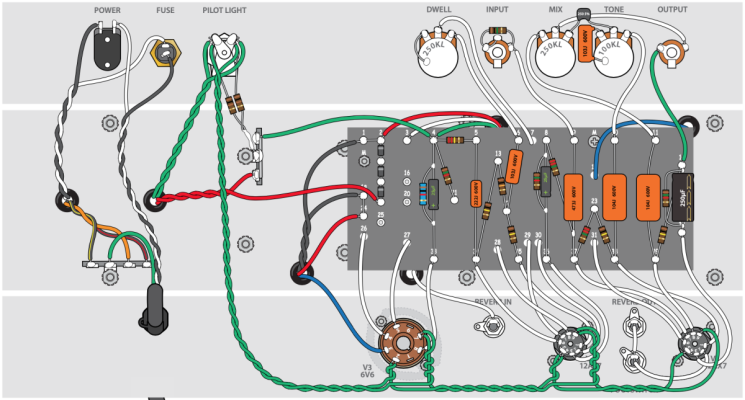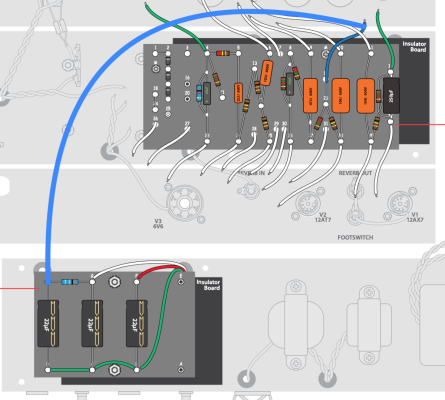birdawesome
Tele-Meister
Hey all, I was hoping to get some insight on a current 6G15 build I'm doing. To be more specific, I'm doing a '63 Reverb Unit Reissue conversion over to a hand wired. Wasn't expecting to get anything out of it other than some knowledge and experience, along with a little fun and personal satisfaction.
However, it's been proving to be quite the headache. I started this conversion wanting to utilize the stock transformers, thereby reducing cost. I bought the small parts kit from Mojotone (https://www.mojotone.com/Mojotone-6G15-Blackface-Reverb-Unit-Small-Parts-Kit) so to get the eyelet boards and all the other parts I'd need.
I finished the build, but was having some further trouble. I had a dry signal output, but no reverb. The tank would "crash" if you gave the box a good wallop, but other than that, nothing returning from the reverb tank. So began the troubleshooting process.
Now, since I'd repurposed the PT, choke, and OT, I was maybe starting to have doubts that my transformers would marry well with the Mojotone wiring diagram I used. I think that the PT is made for full wave, and same with the Mojotone, but I'm not 100% sure on that. Furthermore, my PT gives off 260V, which I don't think is problematic necessarily, but I ended up following StewMac's pdf build troubleshooting section to help me with the troubleshooting process (from what it looks like, the StewMac build just looks like a cleaner, less redundant version of the MojoTone build as far as grounding is concerned). In their guide, the voltages they said to look for coming off of the power section/filter caps would be 420V...I don't think mine was any higher than the 260V or maybe 300V...I can't quite remember, but it was much lower. I don't know if this is problematic or not necessarily considering our PT specs could just be differ, and could be negligible regarding the circuit, but figuring out these kinds of things are a big reason why I wanted to do this in the first place.
Regarding the OT, their diagram only has a blue, red, and yellow wire coming off, whereas mine has a blue, red, green, and black. The way the RI unit was wired initially was with the green connecting to the positive terminal off the RCA jack, and the black going to ground, which I figured I should just follow suit here. The StewMac diagram only has the yellow going to positive, with no wiring connecting to ground. So those are the big differences here. However, something I just discovered that is kind of concerning to me is that when I have my black wire grounded, the green is continuous with it...this seems weird to me. From what my intuition tells me, they both seem to be coming off the same winding on the transformer anyways, but wouldn't this be just sending any signal coming back from the pan straight to ground? Or is this line of thinking incorrect? If not, is the signal jumping off the winding onto the next along the way to the black lead, explaining why this would still work? Or do I possibly have a short?
Furthermore, my voltages on V1 were looking right for the most part, but my voltages on V2 were way off. Most pins weren't reading anything at all. It's obvious to me that something in this path is wrong, but I can't/couldn't explain it. I've since out of frustration decided to strip the entire unit, suck all the solder out of the joints, and test every capacitor with my multimeter again just to see if I had a bad cap or something...all the caps looked fine, which I was kind of hoping wasn't the case, just to make sense of what's going on. I bought all new caps to move forward with, considering my leads were all cut short on the old ones now, and I wanted to do it nice and clean. I've replaced all the orange drops with SoZo's, which are rated at 500V instead of the 600V of the orange drops (this should be fine right? To my knowledge no voltages get that high anyways).
Anyhow, I've essentially begun the build from scratch in a way, but these transformers in particular really got me thinking. Sorry for the long post, but this has been plaguing me for a while. Between working full time and going to school full time I don't have much free time to work on this thing, so it's especially frustrating when I spend any free time I do have on this unit without anything to show for it. Any help/insight that you guys could give me would be GREATLY appreciated.
I've attached both of the diagrams I've been using, if that helps anyone make sense of what I've been doing. Keep in mind, I started with the MojoTone, but I'm redoing the whole thing using StewMac's because it looks like the more elegant of the two.
Thanks in advance!
However, it's been proving to be quite the headache. I started this conversion wanting to utilize the stock transformers, thereby reducing cost. I bought the small parts kit from Mojotone (https://www.mojotone.com/Mojotone-6G15-Blackface-Reverb-Unit-Small-Parts-Kit) so to get the eyelet boards and all the other parts I'd need.
I finished the build, but was having some further trouble. I had a dry signal output, but no reverb. The tank would "crash" if you gave the box a good wallop, but other than that, nothing returning from the reverb tank. So began the troubleshooting process.
Now, since I'd repurposed the PT, choke, and OT, I was maybe starting to have doubts that my transformers would marry well with the Mojotone wiring diagram I used. I think that the PT is made for full wave, and same with the Mojotone, but I'm not 100% sure on that. Furthermore, my PT gives off 260V, which I don't think is problematic necessarily, but I ended up following StewMac's pdf build troubleshooting section to help me with the troubleshooting process (from what it looks like, the StewMac build just looks like a cleaner, less redundant version of the MojoTone build as far as grounding is concerned). In their guide, the voltages they said to look for coming off of the power section/filter caps would be 420V...I don't think mine was any higher than the 260V or maybe 300V...I can't quite remember, but it was much lower. I don't know if this is problematic or not necessarily considering our PT specs could just be differ, and could be negligible regarding the circuit, but figuring out these kinds of things are a big reason why I wanted to do this in the first place.
Regarding the OT, their diagram only has a blue, red, and yellow wire coming off, whereas mine has a blue, red, green, and black. The way the RI unit was wired initially was with the green connecting to the positive terminal off the RCA jack, and the black going to ground, which I figured I should just follow suit here. The StewMac diagram only has the yellow going to positive, with no wiring connecting to ground. So those are the big differences here. However, something I just discovered that is kind of concerning to me is that when I have my black wire grounded, the green is continuous with it...this seems weird to me. From what my intuition tells me, they both seem to be coming off the same winding on the transformer anyways, but wouldn't this be just sending any signal coming back from the pan straight to ground? Or is this line of thinking incorrect? If not, is the signal jumping off the winding onto the next along the way to the black lead, explaining why this would still work? Or do I possibly have a short?
Furthermore, my voltages on V1 were looking right for the most part, but my voltages on V2 were way off. Most pins weren't reading anything at all. It's obvious to me that something in this path is wrong, but I can't/couldn't explain it. I've since out of frustration decided to strip the entire unit, suck all the solder out of the joints, and test every capacitor with my multimeter again just to see if I had a bad cap or something...all the caps looked fine, which I was kind of hoping wasn't the case, just to make sense of what's going on. I bought all new caps to move forward with, considering my leads were all cut short on the old ones now, and I wanted to do it nice and clean. I've replaced all the orange drops with SoZo's, which are rated at 500V instead of the 600V of the orange drops (this should be fine right? To my knowledge no voltages get that high anyways).
Anyhow, I've essentially begun the build from scratch in a way, but these transformers in particular really got me thinking. Sorry for the long post, but this has been plaguing me for a while. Between working full time and going to school full time I don't have much free time to work on this thing, so it's especially frustrating when I spend any free time I do have on this unit without anything to show for it. Any help/insight that you guys could give me would be GREATLY appreciated.
I've attached both of the diagrams I've been using, if that helps anyone make sense of what I've been doing. Keep in mind, I started with the MojoTone, but I'm redoing the whole thing using StewMac's because it looks like the more elegant of the two.
Thanks in advance!




